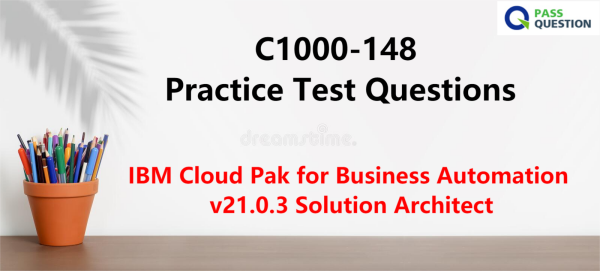C1000-148 Practice Test Questions - IBM Cloud Pak for Business Automation v21.0.3 Solution Architect
C1000-148 IBM Cloud Pak for Business Automation v21.0.3 Solution Architect exam is one of the most popular exams among IBM certification exams. If you want to pass IBM C1000-148 exam on fast track, then getting C1000-148 Practice Test Questions are the easiest way to become certified in the shortest period of time. Our C1000-148 Practice Test Questions will provide you with real exam questions with verified answers that reflect the actual exam. We ensure 100% guarantee to pass the real exam using our C1000-148 Practice Test Questions. If you prepare for the exam using our C1000-148 Practice Test Questions, we guarantee your success in the final IBM C1000-148 exam.

IBM Cloud Pak for Business Automation v21.0.3 Solution Architect
The IBM Certified Solution Architect for IBM Cloud Pak for Business Automation v21.0.3 is an intermediate-level certification for experienced solution architects who have extensive knowledge and experience of IBM Cloud Pak for Business Automation v21.0.3. This solution architect should be able to define the infrastructure requirements, know the overall architecture for Cloud Pak for Business Automation and be able to address performance, security, and sizing. They should be able to choose the correct Cloud Pak for Business Automation capabilities to implement the solution.
Recommended Skills
- Basic knowledge of the architecture of CNCF Kubernetes and OpenShift
- Working knowledge of Linux Working knowledge of OpenShift command-line interface and monitoring
- Basic knowledge of Kafka, Elastic Search, Kibana, and HDFS
- Working knowledge of databases and LDAP Basic knowledge of machine learning
- Basic knowledge of OpenShift container storage
Exam Information
Exam Code: C1000-148
Exam Name: IBM Cloud Pak for Business Automation v21.0.3 Solution Architect
Number of questions: 60
Number of questions to pass: 42
Time allowed: 90 minutes
Languages: English
Exam Topics
Section 1: Platform Planning 29%
- Explain the benefits of Red Hat OpenShift Container Platform and Cloud Pak for Business Automation.
- Explain different deployment patterns (Starter and Production).Explain the high-level deployment process / steps.
- Understand high-level installation requirements.
- Understand component sizing considerations.
- Understand migration and upgrade strategies.
Section 2: Architecture 30%
- Explain the Cloud Pak architecture, including Common Services, Automation Foundation and Operators.
- Describe CP4BA ability for implementing a Hybrid Architecture.
- Categorize the deployment methods available for the software. ex. containerized vs non-containerized.
- Describe Authorization / Authentication concepts (LDAP/IAM / UMS / Teams / Roles).
Section 3: Solutioning 41%
- Explain the functional business capabilities of each of the CP4BA Components.
- Explain the differences between CP4BA capabilities.
- Define the scope of Operational Intelligence within CP4BA.
- Describe the relationship between projects, templates and toolkits.
- Describe understanding of the integration options between capabilities of CP4BA.
- Determine the relevant reference architectures to implement a solution.
- Demonstrate the ability to identify processes as potential candidates for automation.
View Online IBM C1000-148 Free Questions and Answers
What can be used to extract entities, keywords, and relations features from documents?
A.Knowledge Catalog
B.Natural Language Understanding
C.Watson Studio
D.Watson Explorer
Answer:B
In OpenShift Container Platform, if a pod goes down, which component communicates the failure to the master?
A.HAProxy
B.Kubelet
C.API Server
D.Service Proxy
Answer:A
Which Cloud Pak for Automation component needs to be installed to use the Business Automation Workflow recommendation service?
A.Operational Decision Manager
B.Business Automation Application Designer
C.Automation Workstream Services
D.Business Automation Insight
Answer:A
Which of the following is used to generate reports for Bring Your Own Service License (BYOSL)?
A.PassportAdvantage
B.Multi-cloud management license advisor
C.License Service Tool
D.License Metric Tool
Answer:A
Which product can be used by a business analyst to configure an ontology?
A.Business Automation Insights
B.Business Automation Studio
C.Datacap
D.Business Automation Content Analyzer
Answer:A
Which statement is true in order toconfigure Operational Decision Manager (ODM) with User Management Service (UMS)?
A.ODM with UMS supports SAML authentication.
B.The names of the UMS groups must match the names of the ODM groups.
C.The default ODM roles must be modified to match the UMSbase groups.
D.The UMS users and groups must be mapped to an ODM user or group.
Answer:A
In OpenShift Container Platform, what is the smallest compute unit that can be defined, deployed, and managed?
A.Image
B.Project
C.Pod
D.ReplicaSet
Answer:C
What is the most suitable use case for applying machine learning with Business Automation Workflow?
A.Decisionmaking for each step in a business workflow
B.Identification of missing steps in a business workflow for optimization
C.Recommendation of risk event based on predicted next step in a business workflow
D.Identification of a change in the business rules of the organization
Answer:A
- TOP 50 Exam Questions
-
Exam
All copyrights reserved 2025 PassQuestion NETWORK CO.,LIMITED. All Rights Reserved.

